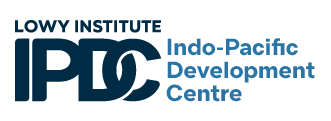After a pandemic-induced lull in spending and new project commitments, China’s Pacific aid engagement has rebounded. With increased spending and a surge in new infrastructure commitments evident in the latest edition of the Lowy Institute’s Pacific Aid Map, released today, Beijing’s program is reemerging with a more refined, Pacific-adapted strategy.
China builds relationships in the Pacific through various channels, with aid and development assistance playing a key role. The Pacific Aid Map has for seven years now tracked China’s efforts, alongside that of other donors. However, despite widespread perceptions of China’s growing clout in the region, its aid spending had fallen away.
The lull
From its spending peak in 2016, China’s Pacific aid program experienced a steep decline. This downturn was driven by a mix of factors: worsening debt sustainability in the Pacific, tighter capital controls in China, and increased competition from traditional partners in the infrastructure sector.
This led into a pandemic period where border closures brought China’s infrastructure-dominant aid strategy to a halt. In 2020, for the first time on record, China signed no new loan financed deals in the Pacific. During this low in its regional engagement, Beijing released a new aid strategy White Paper outlining lower-risk, sustainable development — what Xi Jinping called “Small and Beautiful” engagement.
The rebound
The latest edition of the Pacific Aid Map shows that China has emerged, white paper in hand, from its pandemic-induced stagnation. Total aid spending rose to $256 million in 2022, the latest figures available, slightly surpassing 2020 and 2021 levels. The bump in China's spending, combined with a decline in aid from Japan, New Zealand, and the United States, means China has regained its position as the Pacific's second-largest bilateral aid donor, although it still trails far behind Australia.
More notable than China’s topline spending is the resurgence of new project commitments. This signals a renewed capacity and ambition for China to engage in large-scale projects in the region.
There has also been a marked increase in grassroots, embassy-led initiatives.
A notable example is the $135 million Vanua Levu Road Upgrade in Fiji, announced in 2024 – China’s largest grant-funded project in the Pacific to date. This announcement follows several major project commitments made in 2022 and 2023, including the $75 million Digital TV Transformation Project in Papua New Guinea, the $66 million Huawei cell tower project in Solomon Islands, and the $120 million Malekula Phase III roads project in Vanuatu. The latter two projects represent China’s largest commitments in each of these countries to date.
The recalibration
The way Beijing engages with the Pacific has also changed. Where China once primarily sought to be a loan-financed infrastructure player, it has now transitioned to a grant dominated program. Grants now account for nearly two-thirds of China’s aid to the region, reflecting a pragmatic approach to the Pacific’s economic realities.
There has also been a marked increase in grassroots, embassy-led initiatives. In 2022, China’s Pacific embassies were implementing roughly three times more community-level initiatives than a decade earlier. These projects include everything from vehicle donations, cash grants to schools, and agricultural equipment for farmers. This uptick has reshaped China’s aid profile, with the average project size dropping from $8 million pre-2020 to $2 million post-pandemic.
While many of China’s projects are now “small”, not all new engagements are “beautiful.” The Pacific Aid Map details an increase in large-scale budget transfers, such as contributions to Solomon Islands’ Constituency Development Funds and Kiribati’s Social Stability Fund, both of which lack strong accountability mechanisms. These moves helped China secure diplomatic recognition switches, providing triple the funding previously offered by Taiwan. This trend continues in 2024 with a $20 million budget support package to Solomon Islands.
While loan disbursements remain below pre-pandemic levels, China has signed several large loans with Melanesian states since 2020, including Vanuatu and Solomon Islands, where debt risks have significantly worsened. The lack of transparency around these loans and uncertainty regarding the efficacy of the projects they finance undermine aspects of China’s own debt sustainability frameworks.
Viewed in full, China’s aid program has shown remarkable adaptability over the past five years. Facing a lending decline and pandemic-induced interruptions, Chinese officials have successfully shifted the focus of a constrained budget to maximise impact. While a return to the spending heights of the mid-2010s looks unlikely, China’s recalibrated aid strategy is gaining momentum, positioning Beijing as a competitive, highly visible player in the Pacific aid landscape.


